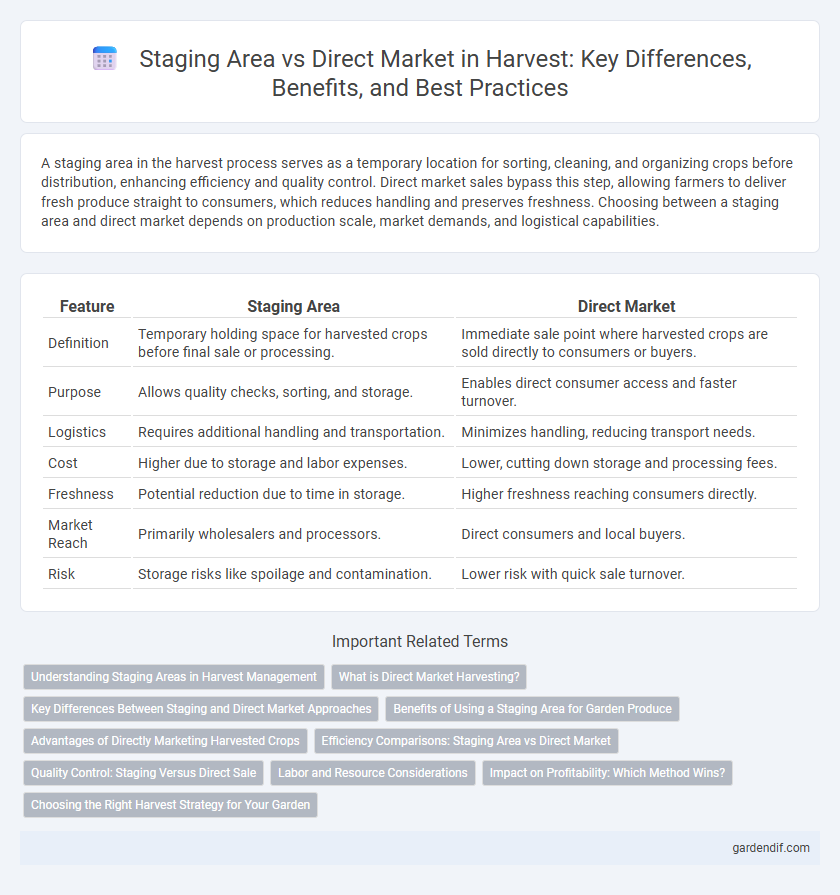
Staging area vs direct market Illustration
A staging area in the harvest process serves as a temporary location for sorting, cleaning, and organizing crops before distribution, enhancing efficiency and quality control. Direct market sales bypass this step, allowing farmers to deliver fresh produce straight to consumers, which reduces handling and preserves freshness. Choosing between a staging area and direct market depends on production scale, market demands, and logistical capabilities.
Table of Comparison
| Feature | Staging Area | Direct Market |
|---|---|---|
| Definition | Temporary holding space for harvested crops before final sale or processing. | Immediate sale point where harvested crops are sold directly to consumers or buyers. |
| Purpose | Allows quality checks, sorting, and storage. | Enables direct consumer access and faster turnover. |
| Logistics | Requires additional handling and transportation. | Minimizes handling, reducing transport needs. |
| Cost | Higher due to storage and labor expenses. | Lower, cutting down storage and processing fees. |
| Freshness | Potential reduction due to time in storage. | Higher freshness reaching consumers directly. |
| Market Reach | Primarily wholesalers and processors. | Direct consumers and local buyers. |
| Risk | Storage risks like spoilage and contamination. | Lower risk with quick sale turnover. |
Understanding Staging Areas in Harvest Management
Staging areas in harvest management serve as temporary holding zones where harvested crops are sorted, graded, and stored before transportation, optimizing logistics and reducing spoilage. Unlike direct market sales where produce moves immediately from field to consumer, staging areas allow for bulk aggregation, better quality control, and coordinated distribution. Efficient use of staging areas enhances supply chain management by balancing demand fluctuations and ensuring timely delivery to markets.
What is Direct Market Harvesting?
Direct Market Harvesting refers to the process of harvesting crops and immediately selling them directly to consumers or local markets without intermediary storage or processing. This method prioritizes freshness and reduces the time between harvest and sale, resulting in higher quality produce and potentially better prices for farmers. Unlike staging areas, where harvested goods are temporarily stored and sorted, direct market harvesting emphasizes rapid distribution to maintain optimal produce condition.
Key Differences Between Staging and Direct Market Approaches
Staging areas in harvest operations serve as centralized locations for temporary storage and sorting, optimizing logistics and quality control before transportation. Direct market approaches bypass intermediate storage, delivering fresh produce straight from the field to consumers, emphasizing speed and freshness. The key differences lie in inventory management, supply chain complexity, and the balance between product handling time and market responsiveness.
Benefits of Using a Staging Area for Garden Produce
Using a staging area for garden produce enhances quality control by allowing growers to sort and inspect fruits and vegetables before reaching the market. This intermediate space reduces waste and spoilage, ensuring fresher products for consumers. Efficient handling and temporary storage facilitate bulk transportation, saving time and reducing logistical costs compared to direct market sales.
Advantages of Directly Marketing Harvested Crops
Directly marketing harvested crops eliminates intermediary costs, increasing profit margins for farmers. It fosters stronger relationships with consumers, enhancing trust and allowing for personalized product offerings. This direct approach also provides faster feedback on product quality and market demands, enabling timely adjustments and improved crop planning.
Efficiency Comparisons: Staging Area vs Direct Market
The staging area streamlines harvest logistics by consolidating produce, reducing transport frequency and lowering overall operational costs compared to direct market deliveries. Direct market sales often require more frequent trips and intricate coordination, increasing time and fuel expenses. Efficiency gains in staging areas include bulk handling and improved scheduling, enhancing throughput and minimizing post-harvest losses.
Quality Control: Staging Versus Direct Sale
The staging area allows for thorough quality control by enabling sorting, grading, and inspection before the produce reaches the market, ensuring only premium products are sold. Direct market sales often bypass these checkpoints, increasing the risk of inconsistent quality and reduced shelf life. Utilizing a staging area enhances product uniformity, reduces spoilage, and improves customer satisfaction in agricultural supply chains.
Labor and Resource Considerations
Staging areas during harvest streamline labor by centralizing operations, reducing worker movement and equipment idle time, and enabling efficient sorting and packaging before transport. Direct market systems require more flexible labor schedules and additional handling resources on-site, increasing labor intensity but allowing for fresher product delivery and faster turnover. Allocating resources effectively between staging areas and direct markets impacts overall harvest efficiency, labor costs, and product quality management.
Impact on Profitability: Which Method Wins?
Harvesting through a staging area enhances profitability by allowing aggregation, quality control, and timing optimization before market delivery. Direct market sales often reduce storage costs and accelerate cash flow but may sacrifice price premiums achievable with bulk, uniform shipments. Data shows staged harvests can increase revenue by 15-25% compared to direct market sales due to improved product consistency and strategic selling windows.
Choosing the Right Harvest Strategy for Your Garden
Selecting the ideal harvest strategy depends on your garden's scale and produce type; staging areas allow sorting, cleaning, and temporary storage that preserve crop quality before reaching markets. Direct market sales offer immediate delivery to consumers, maximizing freshness and reducing handling time but require efficient harvesting schedules and transport. Balancing staging area logistics with direct market demands enhances produce value and supports sustainable garden management.
Staging area vs direct market Infographic

 gardendif.com
gardendif.com